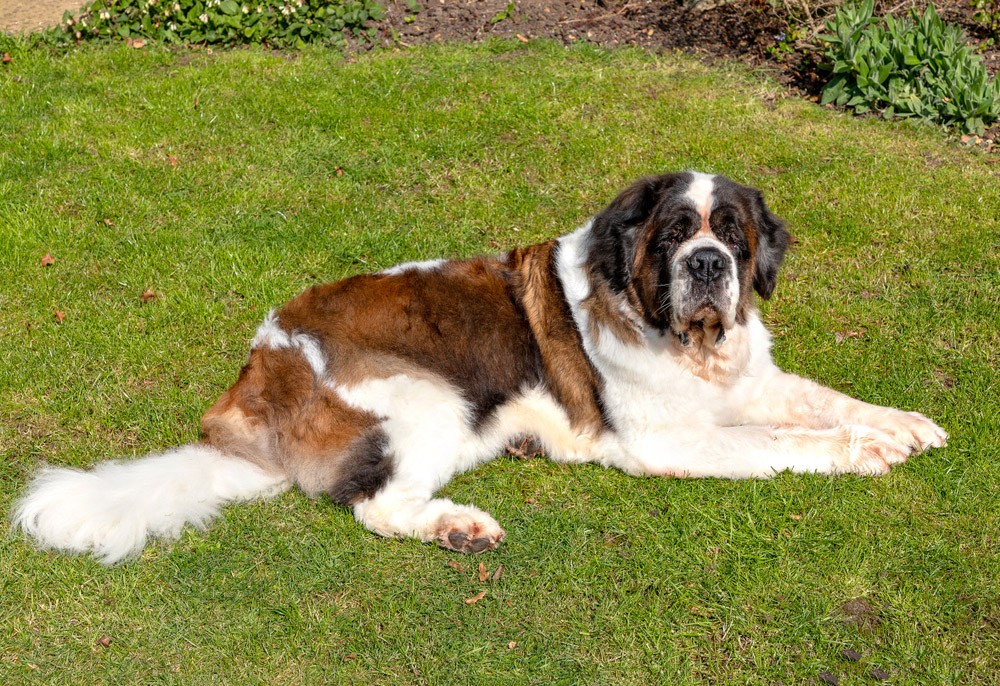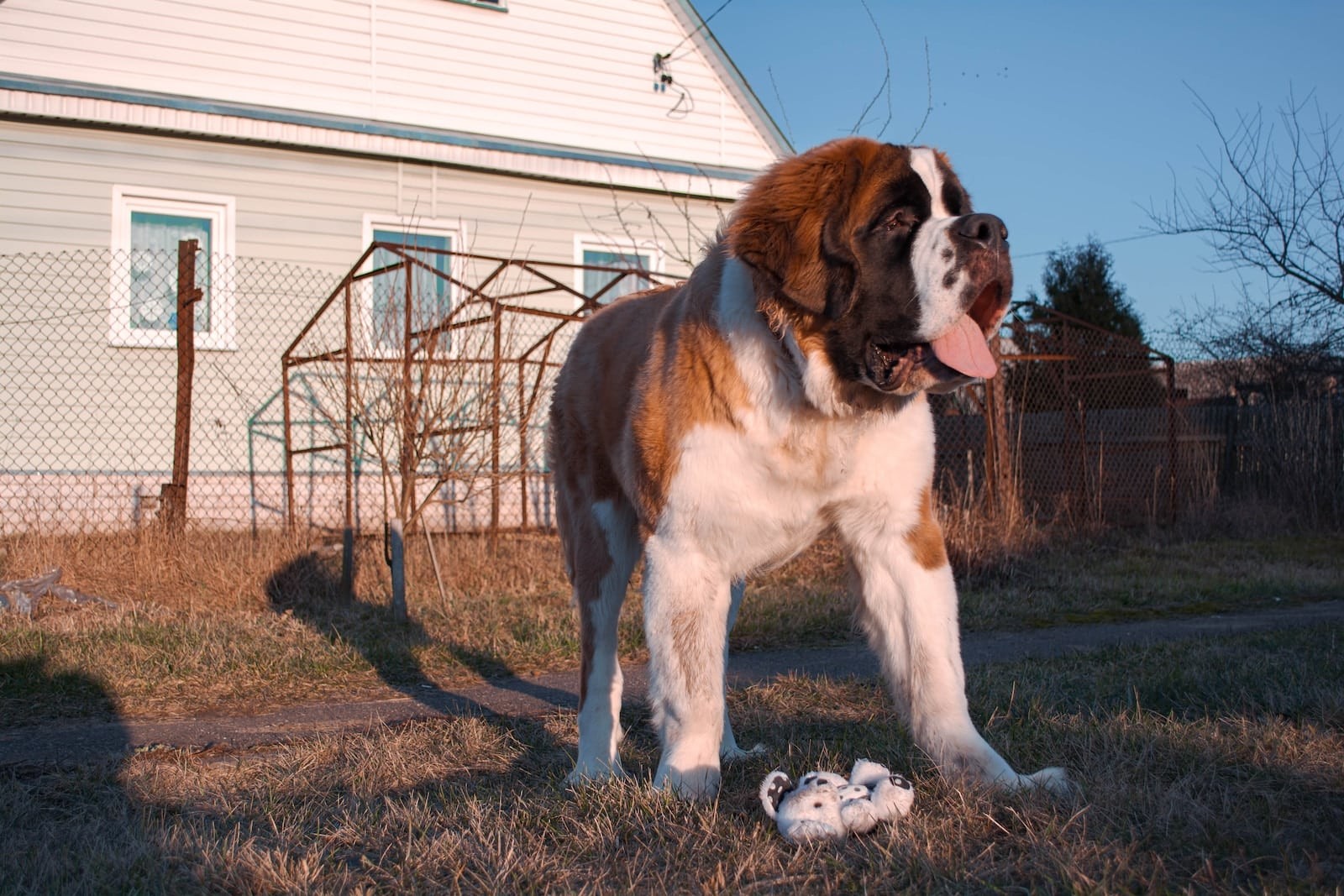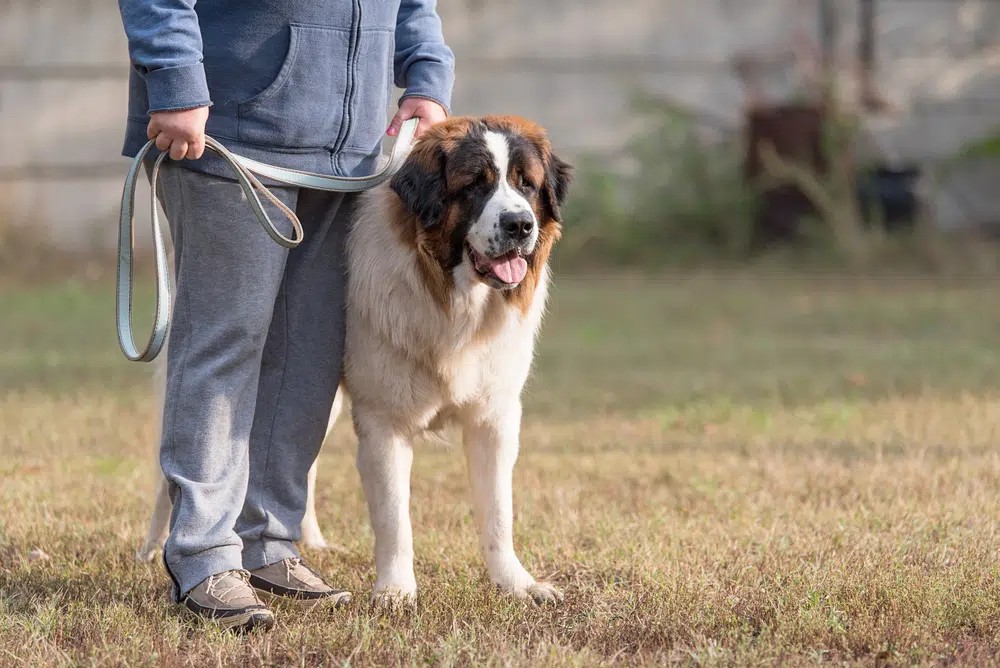The Saint Bernard, or St. Bernard, is a breed that immediately commands attention. Their sheer size is impressive, with some individuals weighing as much as or more than an adult human. Originating from the Swiss Alps, their history traces back to the 17th century, with earlier accounts linking them to the Augustine monks as far back as the 11th century. Named after the Great Saint Bernard Pass between Switzerland and Italy, these dogs were initially bred for rescue work in treacherous mountain conditions. Let’s delve into what it takes to care for a Saint Bernard and determine if they are the right pet for you.
Breed Overview
| Feature | Description |
|---|---|
| Height | 26–30 inches |
| Weight | 120–180 pounds |
| Lifespan | 8–10 years |
| Colors | Brown, mahogany, orange, red, brindle, rust, white, black |
| Suitability | Active families or singles with space and experience |
| Temperament | Loyal, gentle, protective, intelligent, curious |





Recognized by the American Kennel Club (AKC) in 1885 and belonging to the Working Group, Saint Bernards played a crucial role in rescuing travelers in the snowy Alps. They also served as companions and watchdogs for monks. Despite their considerable size and the commitment they require, Saint Bernards are a popular breed, ranking 56th in AKC popularity.1 For experienced owners prepared for the unique challenges of a giant breed, a Saint Bernard can be a deeply rewarding and devoted family companion.
Understanding Saint Bernard Traits
When considering if a Saint Bernard is a good pet, it’s important to understand their key characteristics:
Energy: Saint Bernards have moderate energy levels. While not demanding constant activity, they require daily exercise to maintain their health and well-being.
Trainability: Generally eager to please, Saint Bernards respond well to consistent and positive training methods. Early training is crucial due to their size.
Health: Like many large breeds, Saint Bernards are prone to certain health issues. Understanding these potential conditions is vital for responsible ownership.
Lifespan: Their lifespan is relatively shorter compared to smaller breeds, typically ranging from 8 to 10 years.
Sociability: Saint Bernards are known for their gentle and friendly nature, particularly with their families. Early socialization helps them become well-adjusted dogs.
Saint Bernard Puppies: Starting Right
Image Credit: Kochmarjova, Shutterstock
Finding a Saint Bernard puppy is usually not difficult, reflecting their popularity. However, responsible breeders may have stipulations, such as limited breeding rights or requiring spaying/neutering.
Prioritize purchasing from reputable breeders who conduct health screenings recommended by the Orthopedic Foundation for Animals (OFA).2 This breed is susceptible to hereditary and congenital conditions, making health testing paramount.
Temperament and Intelligence: The Gentle Nature of a Saint Bernard
Saint Bernards are renowned for their sweet and docile temperament. They are deeply loyal and affectionate with their families, forming strong bonds. While generally more reserved with strangers, this trait stems from their watchdog history. Their adaptability and tolerance to cold weather are inherent to their Alpine origins. Saint Bernards are intelligent dogs, a necessity for their historical rescue work, but they also possess an independent nature.
Due to their significant size, Saint Bernards are not typically recommended for first-time dog owners. Early training and consistent socialization are essential. Interestingly, despite their imposing size, they are sensitive dogs and thrive on companionship. This makes them best suited for households where they are not left alone for extended periods, ideally active families or individuals who are frequently home.
Image Credit: Kev Gregory, Shutterstock
Family Friendliness: Are Saint Bernards Good with Children?
Saint Bernards can be wonderful family pets, known for their gentle nature around children. They are generally considered kid-friendly, although supervision is always recommended, especially with younger children. While not known for being excessively nippy, their interactions with small children should be monitored due to their size. A Saint Bernard’s sheer bulk could unintentionally overwhelm a small child during play. Families with older children who understand how to interact respectfully with a large dog may be a particularly good match.
Compatibility with Other Pets
Saint Bernards generally have a low prey drive. However, given their history as watchdogs, they may exhibit some initial reservation towards unfamiliar dogs or other pets. If raised together from puppyhood, a Saint Bernard can often coexist peacefully with other animals in the household. As with children, supervised introductions and interactions are always prudent, especially initially. On a positive note for multi-pet households, Saint Bernards are not excessive barkers, contributing to a potentially quieter home environment.
Essential Considerations for Saint Bernard Ownership
Owning a Saint Bernard comes with unique considerations, best summarized as “more”: more food, more space, more training commitment, and more awareness of potential health concerns. You must have sufficient space both inside your home and in your yard to comfortably accommodate such a large dog. And then there’s the drool – Saint Bernards are known to drool, sometimes quite a bit. Carrying a towel when out with your Saint Bernard is often a practical necessity. Let’s explore these aspects in more detail.
Image Credit: Vlad Rudkov
Dietary Needs and Feeding
Food costs will likely be a significant part of your budget with any dog, but especially with a giant breed like the Saint Bernard. Providing a high-quality dog food formulated for large or giant breeds and appropriate for their life stage is crucial for their health. Large breed puppies, in particular, have specific nutritional needs as they grow more slowly than smaller breeds. Giant breed puppy food helps ensure balanced growth and development.
Feed Saint Bernard puppies three to four times a day, following the food manufacturer’s guidelines. Once they reach adulthood, you can typically reduce feeding to twice daily. Always ensure fresh, clean water is readily available, especially if feeding dry kibble.
Exercise Requirements
Saint Bernards are moderately active dogs. Daily exercise is essential, but it doesn’t need to be excessive. A daily walk of around half an hour is usually sufficient to meet their exercise needs. Outdoor time also provides valuable opportunities for socialization and mental stimulation through new sights, sounds, and smells. Consider puppy playtime at veterinary clinics or doggy daycares for early socialization with other dogs.
If you plan to use dog parks, be sure to check for any size restrictions beforehand. Saint Bernards, due to their size, may not be permitted at all dog parks or may be restricted to specific areas.
Training and Socialization
Begin training your Saint Bernard as soon as they are comfortable in their new home. Remember their sensitivity; positive reinforcement methods are far more effective than harsh corrections. Saint Bernards are generally eager to please and respond well to reward-based training (treats are often highly motivating!). However, be mindful of treat quantities to prevent weight gain.
Saint Bernards are intelligent dogs, historically bred for complex tasks. However, their independence can sometimes present a training challenge. A calm, confident owner who can build a trusting relationship is best suited to train a dog of this size and temperament.
Image Credit: SasaStock, Shutterstock
Grooming Needs
Saint Bernards have a double coat and shed moderately year-round, with heavier shedding periods twice a year. Weekly brushing is essential to manage shedding and prevent matting. Regular grooming sessions are also an excellent opportunity to accustom your Saint Bernard to handling. Incorporate nail trims and ear cleaning into your routine. Regularly handling their paws, ears, and mouth from a young age will make grooming and veterinary exams much easier throughout their life.
Health Considerations
Saint Bernards, like other giant breeds, are predisposed to certain health issues, including joint problems and bloat. Reputable breeders will conduct pre-breeding health screenings to minimize the risk of passing on hereditary conditions. Always seek out breeders who provide health clearances and are transparent about the health history of their dogs.
Choosing a breeder who offers a health guarantee provides further assurance. Whenever possible, meet the puppy’s mother and littermates to assess temperament and overall health.
Minor Conditions:
- Eye Issues
- Hip Dysplasia
- Elbow Dysplasia
Serious Conditions:
- Diabetes
- Degenerative Myelopathy
- Bloat (Gastric Dilatation Volvulus)
Male vs. Female Saint Bernards
The most significant difference between male and female Saint Bernards is size. Males can be considerably larger, sometimes weighing up to 60 pounds more than females. Consider this size difference when choosing a puppy, especially if space is a concern. Temperamentally, males and females are generally similar, particularly with proper training and socialization. While genetics influence personality, environment and training play a crucial role in shaping a dog’s behavior.
3 Interesting Facts About Saint Bernards
-
A Gap in Breed History: There’s a historical gap between early accounts of Saint Bernard-like dogs and formal breed recognition. Written records are sparse for a 700-year period, with visual depictions being the primary evidence of their existence during this time.3
-
Names Evolved Over Time: For centuries, Saint Bernards were simply known by descriptive names related to their work and location, such as “hospice dogs,” “Swiss Alpine Dogs,” “Monastery Dogs,” and “Holy Dogs,” before settling on the Saint Bernard name.
-
The Iconic Barrel’s Artistic Origin: The popular image of a Saint Bernard wearing a small barrel around its neck originated from an 1820 painting by Victorian artist Sir Edwin Landseer titled “Alpine Mastiffs Reanimating a Distressed Traveller.” This artistic depiction, though not based on historical fact, solidified the barrel imagery in popular culture.4
Conclusion: Are Saint Bernards the Right Pet for You?
Saint Bernards are truly remarkable dogs with a rich history of bravery and service. From their origins as Alpine rescuers to their modern-day role as family companions, they possess a unique combination of strength, gentleness, and loyalty. Their affectionate nature and impressive size make them undeniably captivating. However, deciding if a Saint Bernard is a good pet for you requires careful consideration of their needs. They are best suited for experienced owners who can provide ample space, consistent training, and are prepared for the responsibilities that come with owning a giant breed, including potential health concerns and, yes, the drool. If you are ready for the commitment, a Saint Bernard can bring immense joy and unwavering companionship to your life.
Sources
[1] American Kennel Club. Most Popular Dog Breeds of 2022. https://www.akc.org/expert-advice/dog-breeds/most-popular-dog-breeds-2022/
[2] Orthopedic Foundation for Animals. Saint Bernard. Breed-Specific Recommendations. https://ofa.org/chic-programs/browse-by-breed/?breed=SB
[3] Saint Bernard Club of America. Breed History. https://saintbernardclubofamerica.club/breed-history/
[4] Nisba Inc. Sir Edwin Landseer. http://www.nisbainc.org.nz/index.aspx?ID=11
Featured Image Credit: Rita_Kochmarjova, Shutterstock
